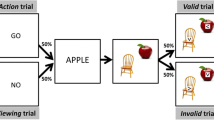Abstract
This study examined the processing of ignored pictures and words when attention was directed to a different picture or word. Previous work by Tipper (1985) demonstrated that the priming effect of an ignored picture on a subsequent categorically related picture is inhibitory. This effect was termednegative priming. Tipper concluded that ignored pictures achieved abstract categorical levels of internal representation, and that these representations were inhibited during selection of a simultaneously presented picture. This conclusion, however, was premature. Observation of the figures used by Tipper suggests that objects within a category have greater structural similarity than do objects in different categories. The negative priming effect could therefore be at a structural level of representation. The present study examined priming across symbolic domains (pictures and words) where there was no structural relationship between objects. Negative priming was again observed and was equivalent to the negative priming observed within symbolic domain. These data suggest that ignored drawings and words do achieve abstract categorical levels of representation, and that the mechanisms underlying negative priming operate at, or beyond, this level.
Similar content being viewed by others
References
Allport, D. A. (1980). Attention and performance. In G. Claxton (Ed.),Cognitive psychology: New directions (pp. 112–153). London: Rout-ledge & Keegan Paul.
Allport, D A., Tipper, S. P., &Chmiel, N. (1985). Perceptual integration and post-categorical filtering. In M. I. Posner & O. S. M. Marln (Eds.),Attention and performance X1 (pp. 107–132) Hillsdale, NJ: Erlbaum.
Anderson, J. R. (1980).Cogmttve psychology and its imphcations. San Francisco W H. Freeman.
Broadbent, D. E. (1958).Perception and communication. London. Pergamon Press.
Broaobent, D. E. (1971).Deciston and stress. London: Academic Press
Broadbent, D. E. (1982) Task combination and selective intake of reformationActa Psychologica,50, 253–290.
Collins, A. M., &Loftus, E. (1975). A spreading activation theory of semantic memory.Psychological Review,82, 407–428.
Deutsch, J. A., &Deutsch, D. (1963). Attention: Some theoretical considerations.Psychological Review,70, 80–90
Eriksen, C. W., Coles, M. G. H., Morris, L. R., &O’hara, L. P. (1985). An electromyographic examination of response competition.Bulletin of the Psychonomic Society,23, 165–168.
Eriksen, B. A., &Eriksen, C. W. (1974). Effects of noise letters on identification of a target letter in a nonsearch task.Perception & Psychophysics,16, 143–149.
Eriksen, C. W., &Schultz, D. W. (1979). Information processing in visual search. A continuous flow model and experimental results.Perception & Psychophysics,25, 249–263
Glaser, W. R., &Dungelhoff, F. J. (1984). The time course of picture-word interferenceJournal of Experimental Psychology. Human Perception & Performance,10, 640–654.
Goldstein, E. B., &Fink, S. I. (1981) Selective attention in vision: Recognition memory for superimposed line picturesJournal of Experimental Psychology: Human Perception & Performance,7, 954–967
Irwin, D. I., &Lupker, S. J. (1983). Semantic prirmng of pictures and words: A levels of processing approachJournal of Verbal Learning & Verbal Behavior,22, 45–60.
Irwin, J. (1979). A method for testing selective attention In vision.Per ception & Motor Skills,48, 899–902
Johnston, W. A., &Dark, V. J. (1986) Selective attention.Annual Review Psychology,37, 43–75
Kahneman, D., &Treisman, A. M. (1984) Changing views ol attention and automaticity. In R Parasuraman, R. Davies, & J Beaty (Eds),Varieties of attention (pp 29–61). New York. Academic Press.
Lupker, S. J. (1979). The semantic nature of response competition in the picture-word interference taskMemory & Cogmnon,7, 485–495.
Meyer, D. E., &Schvaneveldt.R. W. (1971) Facilitation in recognizing pairs of words Evidence of a dependence between retrieval operations.Journal of Experimental Psychology: General,90, 227–234.
Neill, W. T. (1977). Inhibitory and facilitatory processes in selective attentionJournal of Experimental Psychology Human Perception & Petformance,3, 444–450
Potter, M. C., &Faulconer, B. A. (1975) Time to understand pictures and words.Nature,253, 437–438.
Rock, I., &Gutman, D. (1981). Effect of inattention on form perception.Journal of Experimental Psychology. Human Perception & Performance,7, 275–285.
Roediger, H. L., &Nelly, J. H. (1982) Retrieval blocks in episodic and semantic memory.Canadian Journal of Psychology,36, 213–242.
Rosch, E., Mervis, C. B., Gray, W. D., Johnson, D. M., &Boyes-Braem, P. (1976). Basic objects in natural categories.Cognitive Psychology,8, 382–439.
Schneider, W., &Fisk, A. D. (1984). Automatic category search and its transfer.Journal of Experimental Psychology: Learning, Memory, & Cognition,10, 1–15.
Smith, M. C., &Magee, L. E. (1980) Tracing the time course of picture word processing.Journal of Experimental Psychology: General,4, 373–392.
Snodgrass, J. G., &Mc Cullough, B. (1985). The role of visual simdanty in picture categorization.Journal of Experimental Psychology. Learning, Memory, & Cognition,12, 147–154.
Sperber, R. D., Mc Cauley, C., Ragain, R. D., &Well, C. M. (1979) Semantic priming effects on picture and word processing.Memory & Cognition,7, 339–345.
Tipper, S. P. (1985) The negative priming effect: Inhibitory priming by ignored objects.The Quarterly Journal of Experimental Psychology,37A, 571–590.
Tipper, S. P., &Cranston, M. (1985) Selective attention and priming: Inhibitory and facilitatory effects of ignored primes.The Quarterly Journal of Experimental Psychology,37A, 591–611.
Van Der Heijden, A. H. C. (1981).Short-term visual information forgetting. London: Routledge & Keegan Paul
Warren, C., &Morton, J. (1982). The effect of priming on picture recognition.British Journal of Psychology,73, 117–129.
Author information
Authors and Affiliations
Rights and permissions
About this article
Cite this article
Tipper, S.P., Driver, J. Negative priming between pictures and words in a selective attention task: Evidence for semantic processing of ignored stimuli. Memory & Cognition 16, 64–70 (1988). https://doi.org/10.3758/BF03197746
Received:
Accepted:
Published:
Issue Date:
DOI: https://doi.org/10.3758/BF03197746




